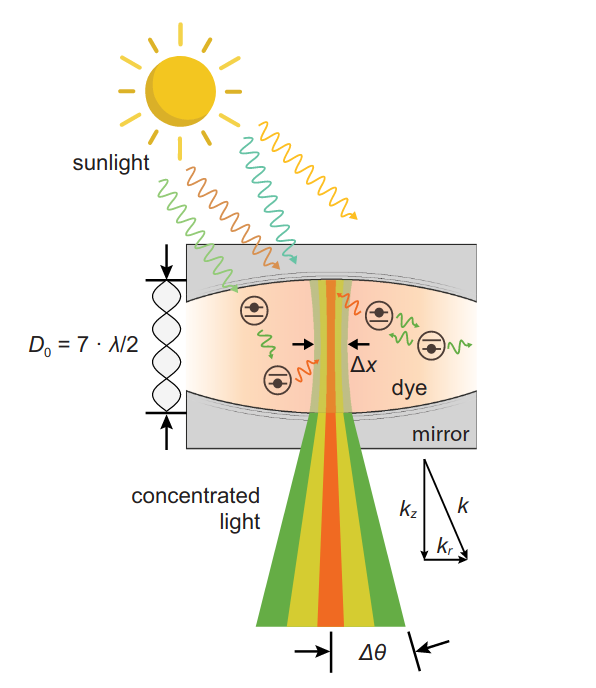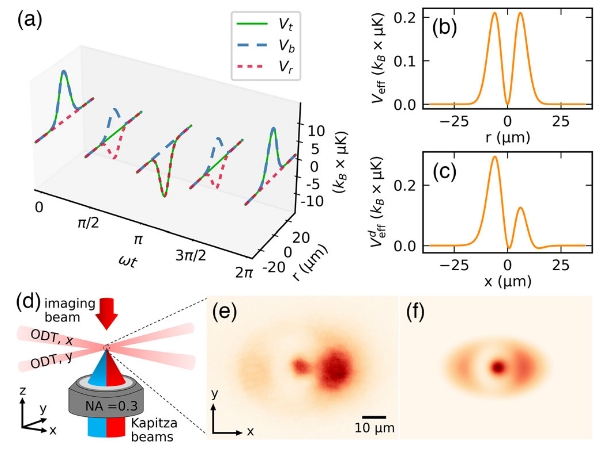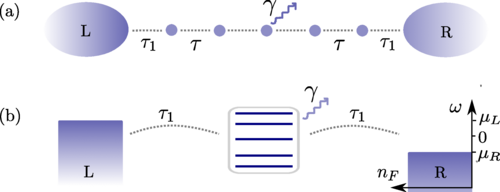Author: Michael Köhl
Sunlight-pumped two-dimensional thermalized photon gas (B1)
Erik Busley, Leon Espert Miranda, Christian Kurtscheid, Frederik Wolf, Frank Vewinger, Julian Schmitt, and Martin Weitz
Phys. Rev. A 107, 052204 (2023)
An ensemble in a closed system has a constant phase-space density. Only when opening up the closed system and allowing, for example, for the injection or removal of particles or energy, we can observe a change of the phase space density. This can occur when the ensemble is placed in contact with a thermal reservoir or when particles can be controllably ejected as in evaporative cooling. Increasing the phase space density of a sample, i.e., cooling the sample while not sacrificing particle number density has a wide range of applications, for example, in the production of degenerate quantum matter. For photons, however, an analogous, efficient path to increase phase space density was so far elusive since photons can be annihilated or created in light-matter interaction and therefore photon number is not conserved. Recent research led by Frank Vewinger, Julian Schmitt and Martin Weitz has taken a first step towards achieving increasing phase space density of a photon gas. To this end, the researchers have funneled sunlight (a thermal distribution of photons corresponding to a temperature of 6000 K) into a dye-filled optical microcavity at a temperature of 300 K. They observed that the photons thermalized with the dye molecules and, somewhat depending on the concentration of the dye molecules, reached a thermal distribution corresponding to 300 K. In terms of phase space density, the sample remained well in the thermal regime because the photon number stayed some five orders of magnitude away from Bose-Einstein condensing the photons due to photon losses. The best possible reduction of phase space density the researchers hoped for was a factor of 370, however, this could not be observed in this first experiment just yet.

Kapitza Trap for Ultracold Atoms (B3)
Jian Jiang, Erik Bernhart, Marvin Röhrle, Jens Benary, Marvin Beck, Christian Baals, and Herwig Ott
Phys. Rev. Lett. 131, 033401 (2023)
Usually, ultracold neutral atoms are trapped in conservative potentials formed by a magnetic potential or an off-resonant laser beam. Suitable choices of internal states (in the case of magnetic traps) and detunings and intensities (in the case of optical traps) provide stable trapping conditions in effectively time-independent potentials. “Effectively” means that the fast dynamics associated with the precessing atomic spin or the flopping of the electric field are averaged out. In contrast, charged particles cannot be trapped in time-independent potentials since no stable static potential exists in vacuum due to Earnshaw’s theorem – only saddle point potentials exist with an attractive potential along one direction and a repulsive potential along another direction. However, it was pointed out by Nobel laureate Wolfgang Paul that dynamical traps could work for a charged particle if the saddle point potential would be modulated in time at an appropriate frequency such that the flip-flopping of the potential together with the inertia of the particle provides dynamical trapping. A similar idea was proposed some twenty years ago for neutral atoms, too, and was now put into practice by the research group of Herwig Ott. They demonstrated that an alternating attractive and repulsive Gaussian potential formed by red- and blue-detuned laser beams, respectively, can trap ultracold Rubidium atoms if, in particular, the oscillation frequency was chosen appropriately.

Nonlinear transport in the presence of a local dissipation (B3)
A.-M. Visuri, T. Giamarchi, and C. Kollath
Phys. Rev. Research 5, 013195 (2023)
A wire, which connects two reservoirs with each other, is one of the fundamental paradigms for studying transport phenomena. Classically, the physics is governed by Ohm’s law which links the current in the wire to the voltage drop via the electrical resistance. In the quantum world, the transport phenomena are more involved. In a recent study led by Corinna Kollath, and in collaboration with Thierry Giamarchi from the University of Geneva, researchers have characterized the particle transport, particle loss, and non-equilibrium steady states in a one-dimensional wire subject to dissipation. Either end of the wire was terminated by an fermion reservoirs with different chemical potentials. The researchers studied a specific form of dissipation created by a local particle loss at a specific point of the wire. This setting is of importance, for example, in mesoscopic physics where the presence of additional electrodes can cause such a form of dissipation or in cold-atom experiments where particle losses are local phenomena. Interestingly, the current through the wire showed step-like features that are affected differently by the local loss: the steps are either smoothed, nearly unaffected, or even enhanced, depending on the spatial symmetry of the single-particle eigenstate giving rise to the step. Moreover, each reservoir is characterized by its independent chemical potential an hence has independent Fermi momenta. The researchers discovered that the transport is governed by two Fermi momenta, which carry the information of the reservoirs rather than the Fermi wave vector corresponding to the density in the wire.

